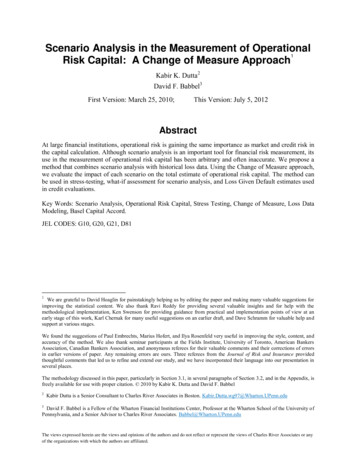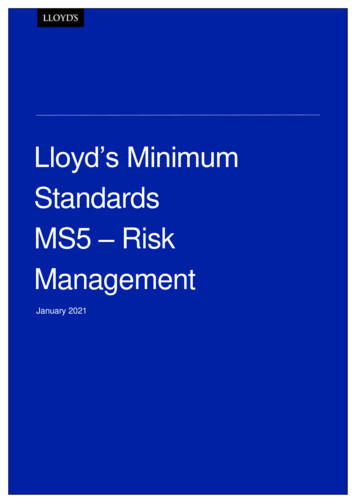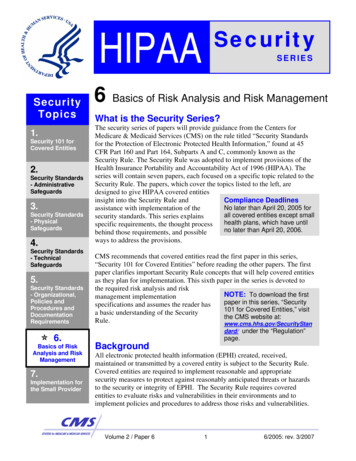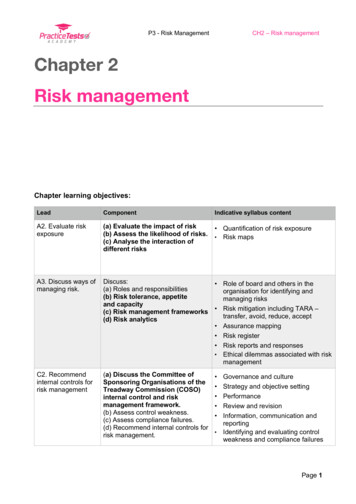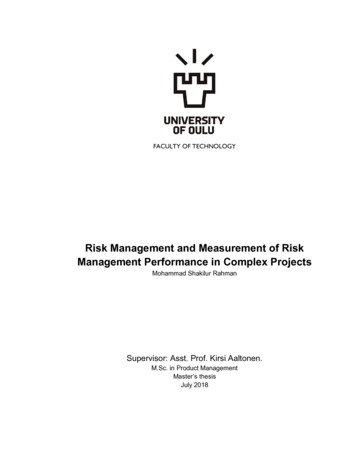
Transcription
FACULTY OF TECHNOLOGYRisk Management and Measurement of RiskManagement Performance in Complex ProjectsMohammad Shakilur RahmanSupervisor: Asst. Prof. Kirsi Aaltonen.M.Sc. in Product ManagementMaster’s thesisJuly 2018
ABSTRACTFOR THESISUniversity of Oulu Faculty of TechnologyDegree Programme: M.Sc. in Product ManagementMMajor Subject (Licentiate Thesis)Author: Mohammad Shakilur RahmanThesis Supervisor: Asst. Prof. Kirsi AaltonenTitle of Thesis: Risk Management and Measurement of Risk Management Performance in Complex ProjectsMajor SubjectType of ThesisRisk ManagementMaster’s ThesisSubmission DateNumber of Pages98, 2 Ap.AbstractIn today’s technologically advanced world, every project, especially large, complex projects are very prone to facingdifferent kinds of risks throughout the project timeline. Project complexity plays a major role in the emergence ofnumerous risks in large projects. In addition, the complexity of projects is on the rise due to various unanticipatedcharacteristics such as, sudden natural phenomena, workplace accidents, increased material costs, etc. Nowadays, projectcomplexity and its corresponding risks are major contributors to project failure. To minimize the impacts of risk, a goodand effective risk management (RM) system must be incorporated into every project. An effective RM system shouldalso include the assessment and measurement of its performance, as this can provide real-time updates about its progress,which in turn can be used to make the RM system more effective and efficient.The aim of this thesis is to gain an insight into risk management literature in the field of complex projects, along withunderstanding of project complexity and the importance of measuring RM performance. In first part of this research, anin-depth review of literature concerning project complexity, project RM and measurement of RM performance ispresented. This is then analyzed and validated using two case projects as examples. The literature review covers how aproject can develop complexity, its underlying managerial actions, the type of risks different complex projects may face,their management plan and finally, the effectiveness of measuring RM performance. Following this, a qualitative casestudy method is followed, whereby two case projects are analyzed in order to gain insights into their RM and riskperformance management procedures.The empirical analysis and findings of this thesis focus on the importance of RM for complex projects. Through theanalysis and discussion, major risks faced by complex construction project, management strategies to mitigate them, RMperformance evaluation strategies and the impact of alliance contracting in RM can be understood thoroughly. Overall,this research provides an in-depth overview of project complexity, RM and its performance measurement for largecomplex projects and it can be used as a basis for further research into RM perspectives in complex projects.Additional InformationKeywords: Risk Management, RM Performance Measurement, Complex Projects, Project Complexity
AcknowledgementIt has been a great experience for me to study this master’s program of Product Managementunder IEM department of University of Oulu. With this master’s thesis, my journey atUniversity of Oulu is going to finish so far, but the experience and lessons I learned fromthis program will be a great addition for my career and knowledge. I would like to expressthanks to all my teachers and classmates who supported me during this study period.During the Risk Management and Advanced Course in Project Management courses, Ibecame interested in risk management and through the practical case studies during thisthesis, I was able to gain more insights into this field.I am deeply grateful to my thesis supervisor Asst. Prof. Kirsi Aaaltonen for all the discussionsand ideas during this thesis work. Kirsi, was really helpful and friendly all the time, whichmade my task much easier. I would also like to express my gratitude to Prof. Jakko Kujalaas my thesis reviewer and to Eija Vieri and Jukka Majava for all support with academicmatters. I would like to thank specially Mr. Mauri Mäkiaho from Rantatunneli project andMr. Toni Hytonen from Tampere Tramway project, who gave me the opportunity to do myempirical analysis on these two projects.I would also like to express my gratitude to my family members, especially my wife, whohas been supporting me from the beginning of this master’s program journey.
Table of ContentsTitle PageAbstractAcknowledgementTable of ContentsList of TablesList of Figures1 Introduction. 81.1 Background of the Study . 81.2 Research Objectives & Research Questions . 91.3 Scope and Structure of the Research . 92Literature Review .112.1 Project Complexity . 112.1.1 Characteristics of Complex Project . 142.1.3 Complexity Factors and Management Strategies . 192.2 Project Risk Management . 212.1.1 Brief History of Risk Management . 232.1.2 Definition of Risk Management . 242.1.3 Categorization of Risk . 262.1.4 Risk Management Process . 292.3 Risk Management Performance Measurement. 352.3.1 Performance Measurement Methodologies. 362.4 Summary of the Theoretical Review . 443 Research Methodology .463.1 Research Design. 463.2 Data Collection . 473.3 Data Analysis Method . 484 Empirical Study .494.1 Tampere Tunnel Project . 494.1.1 Background of Tampere Tunnel Project . 494.1.2 Project Complexity of Rantatunneli . 534.1.3 Risk Management of Rantatunneli . 584.1.4 Risk Management Performance Evaluation . 664.2 Tampere Tramway Project . 69
4.2.1 Background of Tampere Tramway Project . 704.2.2 Project Complexity of Tramway Project . 724.2.3 Risk Management of Tramway Project . 764.2.4 Risk Management Performance Measurement . 814.3 Cross Case Analysis . 825 Discussion .836 Conclusion .896.1 Limitations and Scope for Future Research. 917 Reference .92
List of TablesTable 1: Drivers of simple and complex projects (Javad er al., 2016) . 14Table 2. Project complexity framework (Adapted from Hass et al., 2010) . 15Table 3. Strategies for management of project complexity (Hass et al., 2010). . 20Table 4: Types of risks in different industries (Miller and Lessard , 2001) . 26Table 5: Risk management core and accessory processes (Kahkonen and Artto, 2008) . 35Table 6: BSC perspectives, goals and measures (Kaplan & Norton, 1991). . 38Table 7: EVMS variance analysis (PMI, 2005) . 39Table 8: Types of Indicators (KPI, 2017) . 40Table 9: Top RM Performance measurement KPI category (Excellence in riskmanagement, 2011 & 2013) . 42Table 10: Rantatunneli pre-development milestones (Value for money report, 2014). . 50Table 11: Objectives of the project (Rantatunneli Alliance Project Plan, 2013). . 51Table 12: Project complexity framework validation (characteristics for Rantatunneli projectare highlighted in red) . 55Table 13: Risk categories of the Rantatunneli project. . 62Table 14: Risk grading scale. 63Table 15: Risk severity calculation. . 64Table 16: Risk matrix for Rantatunneli project. 64Table 17: KPI for KRA for Rantatunneli project. . 68Table 18: Positive modifiers for Rantatunneli project. . 68Table 19: Negative modifier s for Rantatunneli project. . 69Table 20: Tracks of section 1 of Tampere Tramway (Tramway Implementation Plan,2017). . 71Table 21: Tampere Tramway project complexity framework validation (characteristics forTramway project are highlighted in red) . 73Table 22: Risks and risk categories of Tampere Tramway project. . 78Table 23: Risk severity calculation for Tampere Tramway project. 80Table 24: Risk matrix for Tampere Tramway project. . 80Table 25: Cross-case analysis. . 82Table 26: KPI for RM Performance Measurement (Farrar 2016) . 89
List of FiguresFigure 1. Research structure. . 10Figure 2. Project business framework (Artto & Kujala, 2008). . 18Figure 3. Factors affecting project complexity (Vidal, 2008). . 19Figure 4: Project risk management steps (Adapted from: PMI, 2016). . 30Figure 5: Risk management steps (Fone & Young, 2005) . 32Figure 6: SHAMPU framework (Ward and Chapman, 2003). . 33Figure 7: Risk management steps (D. van Well-Stam et al, 2004) . 34Figure 9: KPI step (KPI Indicators, 2016). . 41Figure 10: KPI steps (Actionable KPI, 2013). . 41Figure 11: Rantatunneli implementation timeline . 53Figure 12: Spider chart of project complexity . 57Figure 13: Risk management process of Rantatunneli project. . 59Figure 14: RM decision steps. . 60Figure 15: Performance measurement system of Rantatunneli project. . 67Figure 16: Tampere Tramway implementation schedule. . 72Figure 17: Spider Chart of Project Complexity . 75Figure 18: Risk management process of Tampere Tramway project. . 77Figure 19: Risk management team responsibilities. . 78Figure 20: Tampere Tramway project risk management performance measurementprocess steps. . 81
1 IntroductionThis chapter introduces the background to this research, along with its objectives, researchquestions, research scope and structure.1.1 Background of the StudyRisk management is a very known concept nowadays in industry. In recent years, intenseresearch has been conducted on the field of project risk management (RM). Project RM isconsidered one of the most important and critical factors in the ten areas of projectmanagement listed in the PMBOK Guide, alongside integration management, scopemanagement, time management, cost management, quality management, human resourcemanagement, communication management, procurement management and stakeholdermanagement (Project Management Institute, 2016). According to Voetsch et al., (2004),there is significant relationship between the risk managing approach of a business’management and the project’s success. In the modern and rapidly changing business world,companies have wide access to resources and tend to seek the cheapest and most efficientsolution. Many companies focus solely on a core business which makes use of subcontractingvia a third party. Thus, companies try to form alliances with other partners on a single project,in order to improve its efficiency and success. However, this typically increases thecomplexity of the project, as its network grows. Thus, based on these organizational changesand the external environment, many uncertain situations emerge, which in turn makeorganizations and projects more vulnerable to risk. According to Acharyya (2008), everybusiness function is associated with risk, and this risk can affect the business to a large extent.Besides that, due to the advancement of technology, companies’ expectations of projectshave increased significantly. This greater expectation brings additional challenges and as theproject becomes more complex, the probability of exposure to risk also increases. Thisproject complexity is the most crucial factor which significantly increases the likelihood offacing risk during the project. Thus, maintaining and efficiently utilising a proper RM systemincreases the probability of the project’s success.The RM strategy can improve the likelihood of the project’s success, but it is equallyimportant to maintain measurements of the RM system’s performance on a regular basis.Usually, a company takes various initiatives in order to identify the risk and different
corrective measures to solve them, but often they fail to invest enough resources intomonitoring the RM strategy’s effectiveness during the progress of a project (Basova andMitselsky, 2011). Without proper evaluation of RM, an organization is unable to track theprogress of the risk mitigation, which in turn can contribute to a project unsuccessfulness.Thus, it is very crucial to identify the risks, a proper way to manage them and finally,effectively measure management performance properly during a project. It is important thatboth RM and measurement of RM performance are linked together in any complex project.1.2 Research Objectives & Research QuestionsThis research aims to gain an insight into the RM of complex projects and effective ways inwhich to evaluate RM performance.In order to achieve this, three research questions were formulated:RQ1: By what means can project complexity be effectively evaluated?RQ2: What is the importance of measuring RM performance in complex projects?RQ3: How can RM performance be most effectively evaluated in complex projects?The first research question focuses on measuring project complexity and its underlyingcauses and subsequent impact on the project. The second research question focusesparticularly on the evaluation of RM performance and its importance for complex projects.The third research question analyses the different method and ways of measuring project RMperformance.1.3 Scope and Structure of the ResearchThis study mainly focuses on RM and evaluation of RM performance regarding complexprojects. Specifically, this study focuses on identifying different risks and their subsequentimpacts associated with complex projects and approaches to mitigate them. This study alsoplaces emphasis on RM performance evaluation through analyzing different techniques andtools. Another focus of this research is to analyze two practical complex case projects basedon their RM strategies and their performance evaluation.
Chapter 1: Introduction Background Research Need, Objectives and Research Questions Research Scope and StructureChapter 2: Literature Review Risk Management in Complex Projects Risk Performance Management in Complex Projects Project ComplexityChapter 3: Research Methodology Research Design Data Collection Data Analysis MethodsChapter 4: Case Study Case Description Analysis of data gathered from interview and case studyChapter 5: Discussion Comparison of literaure review with the data Reserach Question AnswersChapter 6: Conclusion Summary Limitations of the study Scope for Future ResearchFigure 1. Research structure.
2 Literature ReviewA literature review is fundamentally important in a research project in order to identify anyprevious research on similar topics and to gain understanding of the field’s recentdevelopment. As part of this research, a comprehensive literature review has been undertakenin order to understand project RM, along with RM performance measurement and its impacton complex projects.2.1 Project Complexity“Complexity” is a difficult term to define and there has been a long-ongoing debate over howbest to define it. As many scientists fail to clearly define “complexity” (Johnson, 2006), it isdifficult to give a concise definition here. Complexity can arise when there are variations andfrequent chaos. In the context of a project, it is very difficult to definitively determine whenthis uncertainty and chaos arises. With increasing frequencies of variations and chaos,projects may become more complex day by day. An example of a field which is particularlyprone to complexity and risk is the construction industry. This industry is typically in adisadvantaged state, in terms of dealing with the variation and chaos that can arise (Baccarini,1996). Thus, knowledge about project complexity and ways of dealing with it in differentsituations are particularly important in impacting project success. Mills (2001) supportedBaccarini’s statement by claiming that construction projects are amongst the most volatileand challenging project types and suffer from negative feedback concerning failure to dealwith different challenges. These include missed deadlines, budget overrun, schedulingproblems etc. This statement is supported by Mulholland and Christian (1999), who add thatthe construction business exists in complex and vigorous surroundings with the challenge offacing of various risks and uncertainties, which might result in project scheduling issues andcosts constraints. Another publication by Bertelsen (2003) states that the constructionbusiness is usually thought of as being a linear system which it is managed and organizedeasily through good planning. However, the high rate of failure of construction projects tokeep to their planned time and budget illustrates that the nature of the industry is volatile andunpredictable. Therefore, Bertelsen (2003) views construction projects as being highlycomplex and nonlinear, from which the development of chaos is inevitable.
Baccarini (1996) stated that “project complexity subsists different interconnected parts whichcan be managed with differentiation and interdependency”. According to the author, thisdefinition of project complexity can be applied to any dimension of a project and it isimportant to declare the type of complexity of an issue when utilising the term “projectcomplexity” in order to understand the context. Baccarini (1996) stated that there are twonotable types of project complexity: organizational and technological. Baccarini suggestedemphasizing the concept of project complexity and its subsequent impact as project developscomplexity.Williams (1999) referred to organizational and technological complexity (Baccarini, 1996)as “Structural Complexity”. Willam expressed the concept of “Structural Complexity” asmaintaining a relationship between differentiation and interdependency. This definition canbe applied to multiple project types, regardless of field. There are three types ofinterdependency; pooled, sequential and reciprocal (Williams, 1999; Thompson, 1967). Inpooled structural complexity or interdependency, different departments of the organizationgenerally work independently from one another, but each provides small, individualcontributions, each of which acts as a part of the wider solution. In sequentialinterdependencies, one department’s output is used as another department’s input in themodel. In reciprocal interdependencies are similar to sequential ones, with the output of onedepartment used toward the input of another, but this model contains cyclical characteristics.These are the most critical and complex to manage, as one department’s performance cansignificantly affect others. Later, Williams (1999) added “Uncertainty” as anothercomponent of complexity. According to him, “Uncertainty and Structural Complexity” arethe most critical components which can make the overall project situation very complex andchaotic. Due to this uncertainty, project interdependencies may increase, leading projects toencounter even greater complexity. In order to minimize the effects of uncertainty, the projectmanager may try to change the goal(s) & project action plan. These modifications to theaction plan can then in turn result in increased project complexity two principal areas; theproject’s structural complexity and product complexity (Williams, 1999).Based on the literature concerning “Uncertainty & Structural Complexity”, Geraldi &Albrecht (2007) defined three new terms of complexity; faith, fact and interaction. “Faith”complexity mainly relates to the complexity generated by new and innovative creation,
problem solving along with high uncertainty. “Fact” complexity is related to the complexityarising from personnel’s lack of time or other resources in terms of analyzing large amountsof interdependent and interrelated data, thus needing to make decisions with a degree ofuncertainty. “Interaction” complexity is related and has effects on both Faith and Factcomplexities.Wood & Gidado (2008) cited Gidado (1996) in their interview on project complexityconducted with experts on the construction industry. According to the outcome of theinterviews about project complexity, projects may be summarized as follows: Projects in which a high number of systems are required to be synchronized with oneanother, with many interfaces between them, Projects in which many different complexities exist, making it difficult to achieve theproject’s target or approach the action plan effectively, Projects in which the execution of the project action plan requires consists of a largenumber of details, Projects in which the involvement of many stakeholders is required, along withintensive monitoring and coordination of personnel throughout the project.Based on the outcome of these interviews with construction industry experts, Gidado (1996)depicted two perspectives of project complexity: the managerial perspective and theoperative and technological perspective. In the managerial perspective, different parts of thework are planned and integrated throughout the project, whereas in the operative andtechnological perspective, different technical difficulties that are being faced in terms ofintegrating the work into the project are considered. Gidado (1996) also proposed twosources of project complexity which have an impact on the project. He named these sourcesof complexity as Categories A & B. In category A, complexity is created by components ofindividual tasks relating to resources, whereas in category B, complexity is created by thedifferent parts that are required to make the project’s workflow.Therefore, it may be said that complexity is created through many different channels whichcombine to create chaos in the project. As a project become increasingly complex, it isexposed to greater risks and can potentially become highly vulnerable. This increased
probability of risk typically continues to increase during the project’s life cycle. The literatureconcerning project complexity indicates that the success or failure rate of any project largelydepends upon the degree of project complexity.2.1.1 Characteristics of Complex ProjectA complex project basically consists of several elements along with a large number ofstakeholders. A large or “mega” project may also be called a “complex project”, due to itslarge number of elements and the involvement of multiple. Flyvbjerg (2002) wrote that megaprojects require “very large investment”. He also added that a mega project may, for example,be a “multibillion-dollar large infrastructure project” (Flyvbjerg, 2002). Javad et al. (2016)cited Boardman and Sauser (2006), Cicmil (1997) and Vidal et al. (2011a) and explained thatthe differences between simple and complex projects are dependent upon context, autonomy,belonging, connectivity, diversity, emergence and size. These are summarized in Table 1.Table 1: Drivers of simple and complex projects (Javad er al., 2016)FactorsSimple ProjectComplex inableSizeSmallLargeAccording to Javad et al. (2016), the environment of and the expectation from complexprojects can fluctuate and change continuously. Complex projects have some sharedcharacteristics with simple projects, such as specific goal(s), timeline and budget. However,in addition to these common characteristics, complex projects also typically require a largeamount of investment, highly advanced technology, a large number of stakeholders and/or alengthy construction period, etc. (Baccarini, 1996). These large projects usually consist of
several project subcategories which are managed separately. The larger a project is and thelarger its management, the more complex a project becomes. If a project is large, then itsunderlying technology typically has more advanced features and project managementbecome more complicated. These types of projects have a greater probability of beingexposed to different risks in their life cycles.Hass et al. (2010) presented project complexity characteristics as depicted in Table 2 below,by comparing low, medium and high complexity in terms of project size, cost, uncertainty,etc.Table 2. Project complexity framework (Adapted from Hass et al., 2010)FactorLow ComplexityMedium ComplexityHigh ComplexityTime/Cost 3 months3-6 months 6 months 250K 250-750K 750KTeam Size3-45-10 10Team Composition andStrong project leadershipCompetent projectProject manager isleadershipnot experienced inPerformanceInternal teamleadershipInternal and Externalresources teamComplex teamstructure withvariouscompetenciesUrgency and Flexibility ofMinimized scopeCost, Time and ScopeLittle flexibility inOver ambitiousschedule and budgetscope and scheduleAchievable scope andSchedule is strictlymilestonesfixedSmall milestonesFlexible schedule, budgetNo flexibility inbudget and scopeClarity of Problem,Smooth business objectiveDefined businessUnclear business
Opportunity and SolutionobjectiveobjectiveOpportunity, problem,Problem &partially definedopportunity isEasily understandableproblem, opportunityundefinedRequirements, VolatilityStrong customer supportModerate customerInadequate customersupportsupportunderstood,Requirements areRequirements arestraightforward and stableunderstood, butunclear, volatileand RiskRequirements arechangeable
management listed in the PMBOK Guide, alongside integration management, scope management, time management, cost management, quality management, human resource management, communication management, procurement management and stakeholder management (Project Management Institute, 2016). According to Voetsch et al., (2004),



